Eighteenth Dynasty of Egypt
| Egypt | ||||||||||
| ||||||||||
Capital | Thebes, Akhetaten | |||||||||
Languages | Egyptian language | |||||||||
Religion | Ancient Egyptian Religion | |||||||||
Government | Absolute monarchy | |||||||||
Historical era | Bronze Age | |||||||||
| • | Established | 1549/1550 BC | ||||||||
| • | Disestablished | 1292 BC | ||||||||
| ||||||||||
Dynasties of Ancient Egypt | ||||||||||||||||||
|---|---|---|---|---|---|---|---|---|---|---|---|---|---|---|---|---|---|---|
All years are BC | ||||||||||||||||||
Early
| ||||||||||||||||||
Old Kingdom
| ||||||||||||||||||
First Intermediate
| ||||||||||||||||||
Middle Kingdom
| ||||||||||||||||||
Second Intermediate
| ||||||||||||||||||
New Kingdom
| ||||||||||||||||||
Third Intermediate
| ||||||||||||||||||
Late Period
| ||||||||||||||||||
Ptolemaic (Hellenistic)
| ||||||||||||||||||
The Eighteenth Dynasty of Egypt (notated Dynasty XVIII, alternatively 18th Dynasty or Dynasty 18) is classified as the first Dynasty of the Ancient Egyptian New Kingdom period, lasting from 1549/1550 BC to 1292 BC. It boasts several of Egypt's most famous pharaohs, including Tutankhamun, whose tomb was found by Howard Carter in 1922. This dynasty is also known as the Thutmosid Dynasty for the four pharaohs named Thutmose.
Famous pharaohs of Dynasty XVIII include Hatshepsut (c. 1479 BC–1458 BC), longest-reigning woman-pharaoh of an indigenous dynasty, and Akhenaten (c. 1353–1336 BC), the "heretic pharaoh", with his queen, Nefertiti.
The Eighteenth Dynasty is unique among Ancient Egyptian dynasties in that it had two women who ruled as sole Pharaoh: Hatshepsut, the longest reigning female sovereign of Egypt who is generally regarded as one of the most innovative rulers of Ancient Egypt (of either gender), and King Neferneferuaten, usually identified as the iconic Queen Nefertiti.[1]
Dynasty XVIII is the first of the three dynasties of the Egyptian New Kingdom, the period in which ancient Egypt reached the peak of its power.
Contents
1 History
1.1 Early Dynasty XVIII
1.2 Akhenaten, the Amarna Period, and Tutankhamun
1.3 Ay and Horemheb
2 Dating
3 Pharaohs of the 18th Dynasty
4 Timeline of the 18th Dynasty
5 Gallery of images
6 See also
7 References
8 Bibliography
9 External links
History
Early Dynasty XVIII

Trial piece showing a head of an unknown king in profile. Uraeus on forehead. Limestone relief. 18th Dynasty. From Thebes, Egypt. The Petrie Museum of Egyptian Archaeology, London

Head of an Early Eighteenth Dynasty King, c. 1539–1493 BC, 37.38E, Brooklyn Museum
Dynasty XVIII was founded by Ahmose I, the brother or son of Kamose, the last ruler of the 17th Dynasty. Ahmose finished the campaign to expel the Hyksos rulers. His reign is seen as the end of the Second Intermediate Period and the start of the New Kingdom. Ahmose was succeeded by his son, Amenhotep I, whose reign was relatively uneventful.[2]
Amenhotep I probably left no male heir and the next pharaoh, Thutmose I, seems to have been related to the royal family through marriage. During his reign the borders of Egypt's empire reached their greatest expanse, extending in the north to Carchemish on the Euphrates and up to Kurgus beyond the fourth cataract in the south. Thutmose I was succeeded by Thutmose II and his queen, Hatshepsut. She was the daughter of Thutmose I and soon after her husband's death, ruled for over twenty years after becoming pharaoh during the minority of her stepson, who later would become pharaoh as Thutmose III.
Thutmose III who later became known as the greatest military pharaoh ever, also had a lengthy reign after becoming pharaoh. He had a second co-regency in his old age with his son Amenhotep II. Amenhotep II was succeeded by Thutmose IV, who in his turn was followed by his son Amenhotep III. The reign of Amenhotep III is seen as a high point in this dynasty. Amenhotep III undertook large scale building programmes, the extent of which can only be compared with those of the much longer reign of Ramesses II during Dynasty XIX.[3]
Akhenaten, the Amarna Period, and Tutankhamun
Amenhotep III may have shared the throne for up to twelve years with his son Amenhotep IV, who would change his name to Akhenaten. There is much debate about this proposed co-regency. Some experts believe there was a lengthy co-regency, while others prefer to see a short one. There are also many experts who believe no such co-regency existed at all.
In the fifth year of his reign, Amenhotep IV changed his name to Akhenaten and moved his capital to Amarna. During the reign of Akhenaten the Aten—the sundisk—first became the most prominent deity, and eventually the Aten was considered the only god.[4] Whether this amounted to true monotheism continues to be the subject of debate within the academic community. Some state that Akhenaten created a monotheism while others point out that he merely suppressed a dominant solar cult by the assertion of another, while he never completely abandoned several other traditional deities.
Later Egyptians considered the so-called Amarna Period an unfortunate aberration. The events following Akhenaten's death are unclear. Individuals named Smenkhare and Neferneferuaten are known but their relative placement and role in history is still much debated. Tutankhamun eventually took the throne and died young.[5]
Ay and Horemheb

Block Statue of Ay, c. 1336–1327 BC, 66.174.1, Brooklyn Museum
The last two members of the 18th Dynasty—Ay and Horemheb—became rulers from the ranks of officials in the royal court, although Ay may have married the widow of Tutankhamun in order to obtain power and she did not live long afterward. Ay's reign was short. His successor was Horemheb, a general during the reign of Tutankhamun whom the childless pharaoh may have intended as his successor.[5] Horemheb may have taken the throne away from Ay in a coup. He died childless and appointed his successor, Ramesses I, who ascended the throne in 1292 BC and was the first pharaoh of the 19th Dynasty.
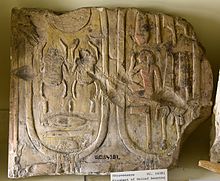
Limestone fragment showing 2 cartouches bearing the throne-name (left) and birth-name and the epithet "god's father Ay the god the ruler of Thebes" (right) of Ay. From Egypt. 18th Dynasty. Petrie Museum of Egyptian Archaeology
This example to the right depicts a man named Ay who achieved the exalted religious positions of Second Prophet of Amun and High Priest of the Goddess Mut at Thebes. His career flourished during the reign of Tutankhamun, when the statue was made. The cartouches of King Ay, Tutankhamun's successor appearing on the statue, were an attempt by an artisan to "update" the sculpture.[6]
Dating
Radiocarbon dating suggests that Dynasty XVIII may have started a few years earlier than the conventional date of 1550 BC. The radiocarbon date range for its beginning is 1570–1544 BC, the mean point of which is 1557 BC.[7]
Pharaohs of the 18th Dynasty
The pharaohs of Dynasty XVIII ruled for approximately two hundred and fifty years (c. 1550–1298 BC). The dates and names in the table are taken from Dodson and Hilton.[8] Many of the pharaohs were buried in the Valley of the Kings in Thebes (designated KV). More information can be found on the Theban Mapping Project website.[9] Several diplomatic marriages are known for the New Kingdom. These daughters of foreign kings are often only mentioned in cuneiform texts and are not known from other sources. The marriages were likely a way to confirm good relations between these states.[10]
| Pharaoh | Image | Throne name / Prenomen | Reign | Burial | Consort(s) | Comments |
|---|---|---|---|---|---|---|
Ahmose I | 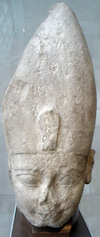 | Nebpehtire | 1549–1524 BC | Ahmose-Nefertari Ahmose-Henuttamehu Ahmose-Sitkamose | ||
Amenhotep I | 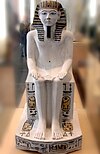 | Djeserkare | 1524–1503 BC | KV39? or Tomb ANB? | Ahmose-Meritamon | |
Thutmose I | 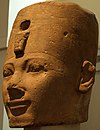 | Aakheperkare | 1503–1493 BC | KV20, KV38 | Ahmose Mutnofret | |
Thutmose II |  | Aakheperenre | 1493–1479 BC | KV42? | Hatshepsut Iset | |
Hatshepsut |  | Maatkare | 1479–1458 BC | KV20 | Thutmose II | |
Thutmose III |  | Menkheper(en)re | 1479–1425 BC | KV34 | Satiah Merytre-Hatshepsut Nebtu Menhet, Menwi and Merti | |
Amenhotep II | 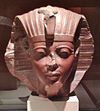 | Aakheperure | 1425–1398 BC | KV35 | Tiaa | |
Thutmose IV |  | Menkheperure | 1398–1388 BC | KV43 | Nefertari Iaret Mutemwiya Daughter of Artatama I of Mitanni | |
Amenhotep III |  | Nebmaatre | 1388–1350 BC | KV22 | Tiye Gilukhipa of Mitanni Tadukhipa of Mitanni Sitamun Iset Daughter of Kurigalzu I of Babylon[10] Daughter of Kadashman-Enlil of Babylon[10] Daughter of Tarhundaradu of Arzawa[10] Daughter of the ruler of Ammia[10] | |
Amenhotep IV/Akhenaten | 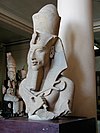 | Neferkepherure-Waenre | 1351–1334 BC | Royal Tomb of Akhenaten | Nefertiti Kiya Tadukhipa of Mitanni Daughter of Šatiya, ruler of Enišasi[10] Meritaten? Meketaten? Ankhesenamun Daughter of Burna-Buriash II, King of Babylon[10] | |
Smenkhkare | 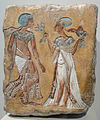 | Ankhkheperure | 1335–1334 BC | Meritaten | ||
Neferneferuaten | 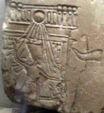 | Ankhkheperure | 1334–1332 BC | Akhenaten? Smenkhkare? | Usually identified as Queen Nefertiti | |
Tutankhamun |  | Nebkheperure | 1332–1323 BC | KV62 | Ankhesenamun | |
Ay |  | Kheperkheperure | 1323–1319 BC | KV23 | Ankhesenamun Tey | |
Horemheb | 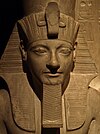 | Djeserkheperure-Setepenre | 1319–1292 BC | KV57 | Mutnedjmet Amenia |



Comments
Post a Comment